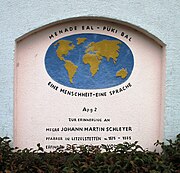Portal:Constructed languages/Language of the month/July 2014

Volapük (/ˈvɒləpʊk/ in English; [volaˈpyk] in Volapük) is a constructed language, created in 1879–1880 by Johann Martin Schleyer, a Roman Catholic priest in Baden, Germany. Schleyer felt that God had told him in a dream to create an international language. Volapük conventions took place in 1884 (Friedrichshafen), 1887 (Munich) and 1889 (Paris). The first two conventions used German, and the last conference used only Volapük. In 1889, there were an estimated 283 clubs, 25 periodicals in or about Volapük, and 316 textbooks in 25 languages; at that time the language claimed nearly a million adherents. Volapük was largely displaced in the late 19th and early 20th centuries by Esperanto and Ido.
Schleyer first published a sketch of Volapük in May 1879 in Sionsharfe, a Catholic poetry magazine of which he was editor. This was followed in 1880 by a full-length book in German. Schleyer himself did not write books on Volapük in other languages, but other authors soon did. Find out more...
